- Digital and Design Strategy
- Digital Marketing
- Updated 08/13/2025
Building a Smarter Digital Marketing Strategy Framework: A Blueprint for Sustainable Growth
Summarize this post

Digital marketing is more than just a buzzword; it’s the backbone of modern business strategies. But what exactly qualifies as digital marketing? It’s any promotional activity carried out online, from social media ads to email campaigns and search engine optimization (SEO).
A digital marketing strategy is your game plan, outlining how your business will achieve its marketing goals through specific online channels. Without a clear strategy, efforts can feel scattered, wasting time and money.
This article dives into the elements of a comprehensive digital marketing strategy using our in-house Propagate Digital Marketing Strategy Framework. Whether you’re a seasoned marketer or a small business owner, this guide will equip you with the knowledge to build a robust strategy that drives results.
The components of the Propagate Digital Marketing Strategy Framework are:
- Goals & Objectives
- Ideal Customer Profiles
- Competitive Landscape
- Positioning & Messaging
- Marketing Channels
- Acquisition Strategy
- Content Strategy
- MarTech Stack
- Budget Allocation
- Implementation Plan
Let’s explore each component of the framework.
Goals, Objectives, and KPIs
Every journey starts with a destination. If you don’t know where you’re going, you’ll end up somewhere else. Objectives are the business outcomes you hope to achieve by implementing your digital marketing strategy. These objectives guide and focus your marketing efforts, ensuring your investment moves your business toward the desired results. Without clear objectives, you’ll inevitably allocate resources toward ineffective marketing activities, wasting time and money.

Objectives are the significant, overarching outcomes you want to accomplish, such as increasing top-of-line revenue, generating a specific sales pipeline, or building brand awareness. Each objective will have goals associated with it. Increasing top-of-line revenue might have a goal related to generating more sales-qualified leads (SQLs.) Each Goal should also have a Key Performance Indicator (KPI) attached. KPIs measure the effectiveness of the campaign at accomplishing the goal, allowing you to monitor and correct as needed.
Setting Goals
Not all goals are created equal. Marketing goals should use the SMART format, Specific, Measurable, Achievable, Relevant, and Time-bound. For example, instead of saying, “increase website leads,” aim for “increase sales qualified leads by 20% in six months.” Without using this format, you can land on goals that you can’t measure, aren’t relevant to your objective, or are unclear when you can determine if the campaign has been successful.
Be mindful of the quantity of goals you are setting. While you want “stretch goals” that will be meaningful when achieved, having too many goals can fragment the campaign’s focus, make it harder to reach any goal and add to the complexity of measuring and monitoring each goal. We recommend limiting campaign goals to no more than five, and ideally three or fewer. If you have more goals, consider prioritizing and focusing on the three highest priority goals to start, and once you’ve achieved them, move on to the lower priority goals.
Determining KPIs
As mentioned earlier, each goal should have one or more Key Performance Indicators (KPIs) that measure progress toward the goal. KPIs are most effective when quantitative, meaning they’re measured via numbers and data. While some goals may be more manageable quantitatively, you can often find ways to measure less data-driven goals. For example, if your goal is to change brand perception, you could measure success with regular customer surveys designed to tally up a “perception score” to track the evolving perception of your brand.
Additionally, KPIs can be divided into leading and lagging indicators. Leading indicators are early signs of success but don’t measure the desired outcome, such as website visits or email open rates. Lagging indicators measure the desired result, such as leads generated or customer retention.
Ideal Customer Profiles
An Ideal Customer Profile (ICP) describes the customer segment that would most benefit from your product or service. To effectively reach and persuade your audience, you must understand who they are, their pain points, and how they think and behave. Most businesses have more than one ICP, meaning portions of their target audience have different needs, behaviors, and thought patterns. For this reason, the first step in creating your ICPs is to define 3 to 5 audience segments, grouping users based on common characteristics.
Once you’ve defined your customer segments, you need to do audience research to develop a clear understanding of who these individuals are.
Performing Audience Research
There are several methods to learn more about your target audience. The most effective methods are the ones where you gain information directly from your target audience. Examples include:
- Conducting one-on-one customer interviews to learn their pain points and goals
- Conducting focus groups to interview multiple customers at a time
- Running customer surveys for quantitative insights
- Monitoring social media activity to uncover trends
- Analyzing website behavior using tools like Google Analytics, HotJar, or MS Clarity
Direct access and customer feedback aren’t always possible; to some extent, customers are expected to report some questions inaccurately. This happens because customers might be self-conscious and uncomfortable sharing their true feelings. Also, some people are more self-aware than others and sometimes don’t fully understand why they’re motivated or how they respond in specific situations. For these reasons, we recommend you connect with any customer-facing roles within your organization, such as the sales, marketing, and customer support teams.
Building Buyer Personas
Armed with a clear understanding of your ideal customer segments, you can create buyer personas. Buyer personas are fictional representations of your ideal customer segments. Each persona represents a singular individual with the story and common attributes you’ve identified through your research. Effective personas focus on more than demographics like age or income and instead prioritize psychographics–what drives their decisions, concerns, and objections.
Make sure to include:
- Common questions
- Common pain points
- Motivators (logical and emotional)
- Triggers for action
- Decision-making criteria
- Empathy maps: What are they thinking, feeling, and saying?
The goal is to have a marketing asset you can share with the organization to understand your target customers and a tool to inform the rest of your digital strategy. The information documented in your buyer personas should inform and validate every marketing decision moving forward.
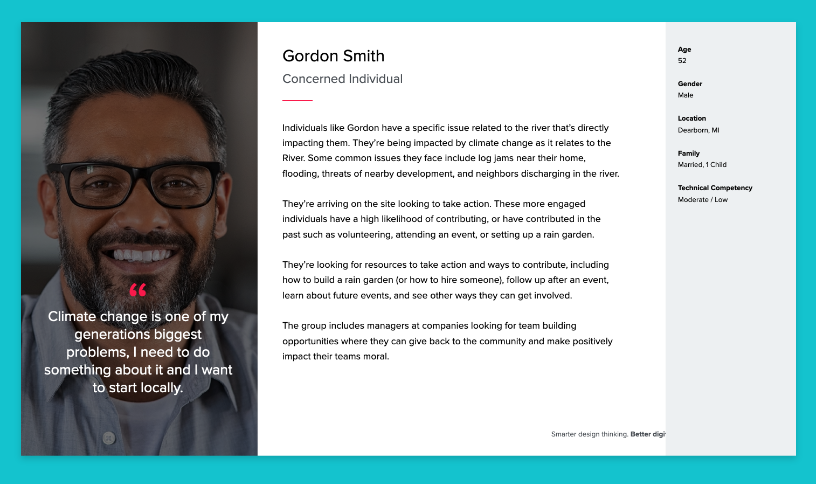
Mapping the Buyer’s Journey
With your buyer personas built, you need to understand their journey when making a purchase decision. This is accomplished through Buyer Journey Maps, which visualize how your target audience interacts with your business, from awareness to decision-making. You start by identifying their behavior once they become “problem aware,” the stage where your customers realize they have a problem but are unsure how to solve it. The map then looks at each stage in the journey after they engage with your business and documents relevant details such as:
- What they’re doing?
- What are they thinking?
- How are they feeling?
- What questions do they have?
- What reservations do they have?
- What moves them to the next stage?
- What brand touch points are occurring?
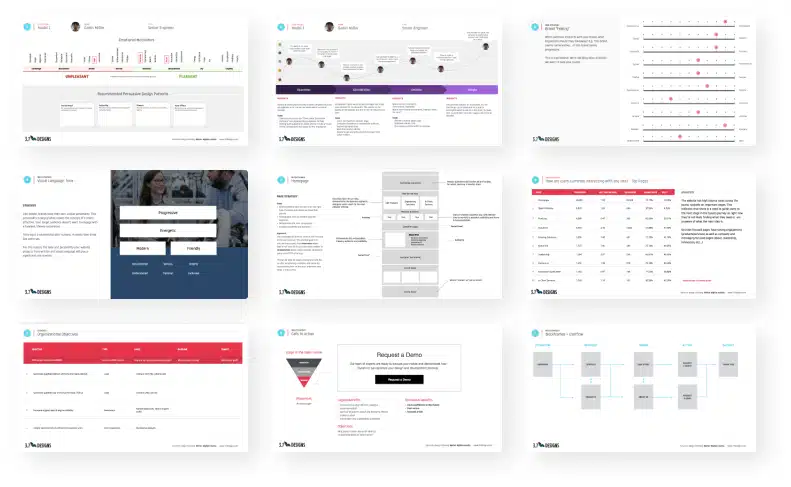
Buyer journey maps are critical for effective targeting, i.e., how and when we reach our audience, and messaging, i.e., what we say to them at each stage in their journey to keep them engaged and moving down the funnel.
Competitive Landscape
Modern buyers are skilled researchers who will consider multiple options to solve their problems, including direct competitors and alternative solutions. Understanding the competitive landscape will help with positioning and messaging and identify gaps and opportunities.
Plan on studying direct competitors, indirect competitors, and alternative solutions. Direct competitors are businesses and solutions that most closely match your own. Indirect competitors are solutions that achieve the same outcome but through a different approach. For example, a marketing agency might have an indirect competitor in a sales enablement agency. Alternative solutions accomplish the same result but through a different method, meaning instead of hiring an outside agency, one might employ in-house resources.
We recommend studying 2–3 direct and 2–3 indirect competitors and alternative solutions. For each, you’ll want to conduct a SWOT analysis, and for competitors, audit their current marketing strategy.
Conducting a SWOT Analysis
Before auditing a competitor’s digital marketing efforts, it is essential to conduct a broader audit, evaluating how competitive you are with the competitor on a business level. This can be done by performing a SWOT analysis, a classic business framework used to assess a business’s core aspects.
SWOT analysis is a timeless framework that can evaluate your business’s competitiveness. SWOT is an acronym that stands for:
- Strengths: What are they doing well?
- Weaknesses: Where are they falling short?
- Opportunities: What can you capitalize on?
- Threats: What risks do they pose?
To perform a SWOT analysis, gather information from a competitor’s website, social media, customer reviews, press releases, and industry reports. If you have any customers who’ve switched from a competitor, they can also be a great source of information.
After completing your research, analyze the business’s strengths. What areas do they excel at? Do they have superior products? Strong branding? or more market share? Next, identify their weaknesses, such as poor customer service, reliability issues, or lacking features.
You should be able to identify opportunities and threats based on the competitor’s strengths and weaknesses. Opportunities typically arise when your business is strong and your competitor is weak. You may also find an opportunity to improve one of your weaknesses to match a competitor’s current strength. Threats are often the inverse: Where is your competitor strong and you weak? Can the competitor increase their strength in an area where you currently have the advantage?
This process reveals how your competitor operates and helps identify where your business can differentiate and gain a competitive edge. Your differentiators will be the cornerstone of your messaging, ensuring your target audience understands why they should buy from you and not your competitors.
Once you’ve completed your SWOT analysis, you can begin auditing your competitor’s marketing efforts.
Analyze Their Content and Channels
Marketing competitive audits start by analyzing the marketing channels the business is participating in, such as social media, podcasting, paid media, etc. Reviewing each channel and assessing engagement, you will understand which channels effectively reach your target audience.
Suppose all your competitors are on X, but none have a notable follower count and poor engagement. In that case, it means either there is a substantial opportunity to outperform your competitors on the channel, or it’s a poor channel for reaching your target audience.
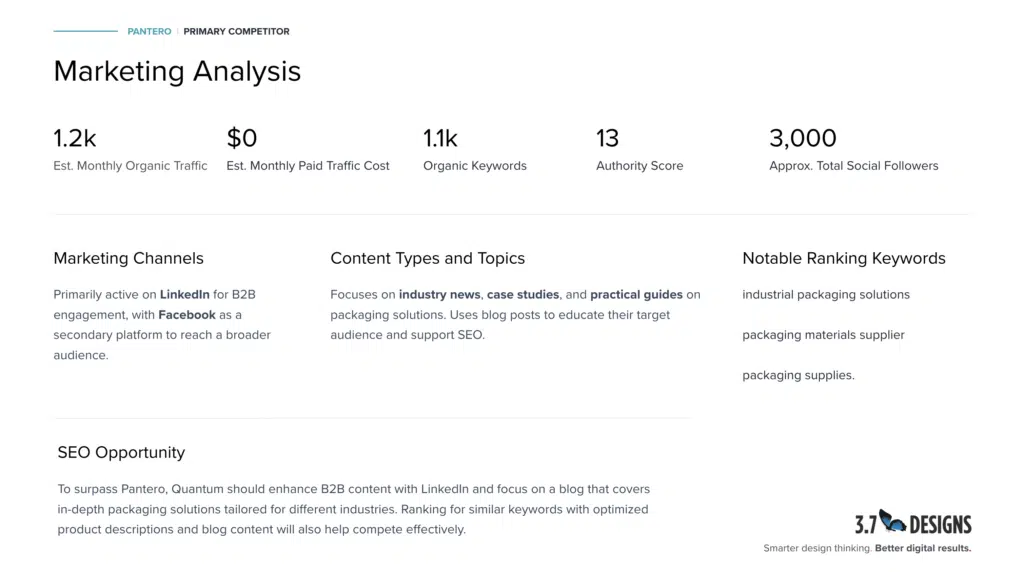
For each channel, first document the followers and subscriber counts, posting frequency, and engagement. Next, map out the topics the competitor is publishing content around. The idea is to identify what “themes” of content they’re posting, for example:
- Company news
- How-to’s
- Industry news
- Comparisons
- Tutorials
- Lifestyle
You can also assess the engagement they’re receiving for each topic and what calls to action they’re using. This data gives insight into what topics you should consider, which you should avoid, and what calls to action do or don’t work based on the topic.
Finally, conduct a website audit and document unique selling positions, differentiators, content topics, user experience, and SEO. Similar to other marketing channels, auditing your competitor’s websites will help inform how you can differentiate, what content or features you should include because your audience will expect it, and what mistakes or issues to avoid that you identify your competitors are doing.
Once your competitive audit is complete, you’ll have the insights to determine your messaging and positioning.
Messaging & Positioning
Positioning defines how your brand is perceived relative to competitors. It’s about finding your unique spot in the market. Your positioning informs your messaging, which are the 1 – 3 primary things you want your target audience to think of when they think about your brand.
Identifying Your Positioning
Based on your competitive audit, you should have a list of ways your brand differs from your competitors. Identify the differentiators that provide the most value to your target audience and prioritize them from most valuable to least valuable. The most valuable differentiator (or sometimes a combination of differentiators) becomes your Unique Value Proposition (UVP).
Your UVP is the primary message you want your audience to associate with your brand. All of your marketing messaging should reinforce your UVP.
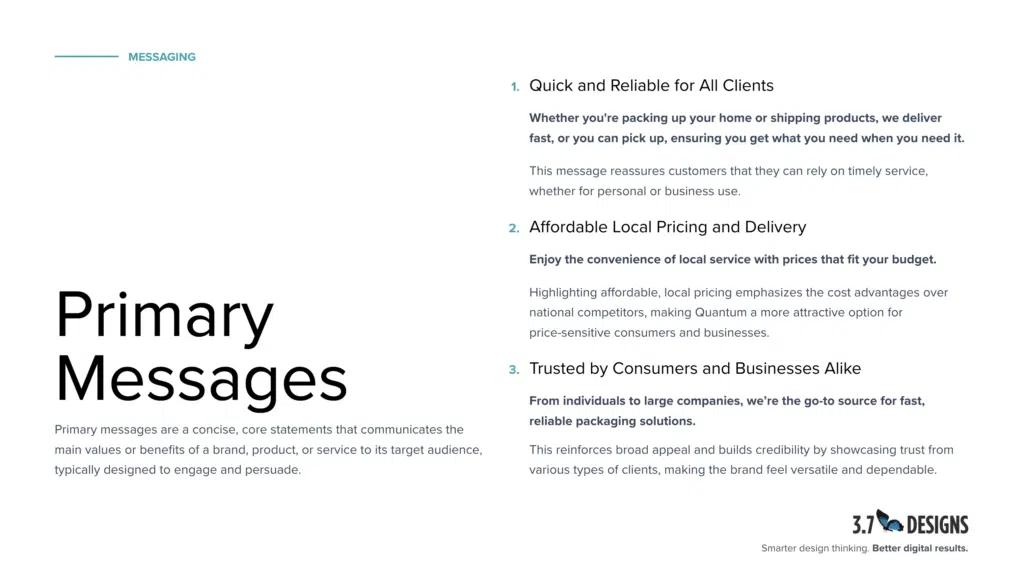
Supporting Messaging
Unfortunately, you can’t expect to repeat your UVP in every advertisement, piece of content, and website and expect it to sink in. Marketers must contend with two psychological principles. First, we are naturally more adept at spotting differences than similarities. The more you repeat the same message, the less likely your audience will notice it. Second, and contradictory, it takes frequent exposure before a message becomes engrained in your audience’s minds.
The solution is to create several “primary messages” supporting your UVP without repeating or rewording it. For example, if your UVP is focused on having the most reliable solution in the market, you would develop several messages that speak to an aspect, benefit, or outcome of having a reliable solution. You could focus on the low percentage of downtime, how reliability issues negatively impact your audience, etc…
Because each message is unique, your audience is more likely to notice them, and because they all reinforce your UVP, they begin to associate your brand with that unique position.
Once you know what you will communicate to your audience, you must figure out how to reach them.
Target Channels
Marketing channels are platforms or media you use to reach your target audience. Examples include social media, websites, search engines, email, and content marketing. Even with an unlimited budget, trying to leverage every marketing channel is not wise. Focusing on the channels where your audience spends the most time and where you are most likely to engage with them is more effective.
Selecting the proper channels comes down to four considerations:
- Where does your audience spend their time?
- How equipped are you to reach your audience on the channel?
- Do you have the resources to support the channel?
- What’s the effort vs. potential impact of each channel?
Each channel needs a tailored approach. For example, even though LinkedIn and Instagram are social media, the content and format you publish on them should differ based on their unique attributes, even if the overall message is the same. Some channels, like search engines, are better at reaching Bottom of the Funnel (BOFU) leads, whereas others are best for the top and middle of the funnel, where you will need to nurture leads and contacts before they’re ready to buy.
Acquisition Strategy
Unless you’re already wildly successful on a particular channel, you must develop a strategy for building an audience. When you create that social profile or set up a new website, you’ll have zero followers and zero traffic. Don’t expect your audience to hunt you down with zero effort on your part; you need to proactively get in front of them and provide a compelling reason for them to engage.
Typically, you’ll build an audience through paid media, organic means, or both.
Paid Media
Paid media involves leveraging ads and sponsorships to reach your audience. Most social platforms have campaigns specifically for building followers. You might be tempted to use your ad spend to drive sales-qualified leads directly, but you should consider the long-term value of an engaged audience. Acquiring followers is often cheaper than generating a lead, and each follower is a future lead opportunity.
Organic
Organic acquisition is where you try to reach your audience through unpaid means. Typically, this means posting content, engaging in conversations directly, engaging in public relations, being a guest on podcasts, etc… Organic is a compelling long-term strategy as it builds upon itself. Once you develop a system to reach your audience organically, it tends to snowball, becoming more effective over time.
It is typically slow, however. You can spend months (maybe years) posting content before you reach a critical mass. This is why it’s valuable to use both paid and organic efforts. The paid media helps build your initial following, giving your organic efforts greater reach.
Content Strategy
Content is how you’ll interact with your target audience. Whether organic social posts, videos, blog articles, case studies, or even advertisements and direct messages, you’ll need to develop a strategy of what content you’ll create and all the details required to create and publish the content.
Starting at the highest level, develop a topic map that organizes the core topics and subtopics around which you’ll create content. These topics should relate to your core messages and your audience’s interests. The goal is to create content your audience wants to engage with because it helps solve their problems or provides value. Along the way, you can gently incorporate your marketing messages into the content to work on those eight touchpoints required before the message becomes engrained in memory.
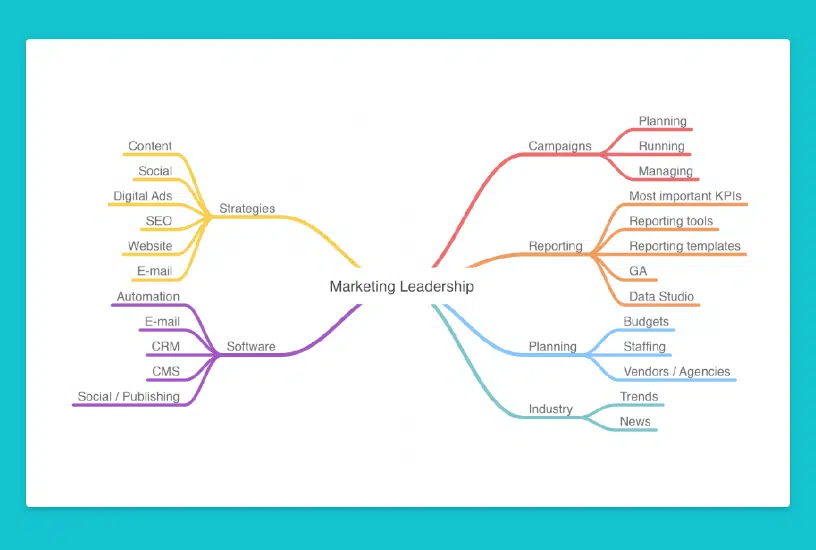
For each of your core topics, identify opportunities for “pillar content.” Pillar content is long-form, foundational pieces that can be split and repurposed into shorter-form content. For example, a ten-minute company promotional video could be repurposed into one-minute clips, multiple social posts, converted into blog content, or potentially turned into a podcast. Repurposing your content is more efficient than creating dozens of stand-alone pieces.
Once you’ve identified your pillar content and its supporting content, you’ll need to plan the logistics of creating and publishing it. Who will create the content? When will they create it? What assets or skills will be required? When do you plan on publishing it, and on what channels? How will you promote it?
Finally, you can’t manage the effectiveness of your content without measuring it. Define the metrics and tools you’ll use to assess performance. Depending on the channel, reporting tools might be natively available, like impressions, clicks, likes, shares, etc… in other cases, you’ll need to leverage third-party tools like Google Analytics or HubSpot.
MarTech Stack
Modern marketing campaigns require technology to perform at its peak. Proactively identifying what Marketing Technology (MarTech) you’ll use to facilitate and measure your campaign is a critical but often overlooked step.
- What solution are you going to use for conversion forms?
- Where will leads be managed?
- What platform will you use for marketing automation?
- Do you need a social posting solution to keep reporting and publishing in one place?
Your specific circumstances will dictate the technology that best suits your needs. For example, we recently launched a campaign using HubSpot for lead forms, storing leads and contact details (CRM), marketing automation to nurture leads, and cross-platform social posting and reporting. Additionally, we leveraged Google Analytics and MS Clarity for website tracking and SEMrush for organic search.
Investing in the right technology streamlines processes and boosts efficiency.
Budget Allocation
No marketing effort is free. There will be out-of-pocket costs for vendors, salaries (including your own), ad spend, and technology. If you have a known budget, it’s best to work backward and identify how best to allocate it toward specific portions of the campaign. If you’ve determined that advertising will be critical in reaching your audience, you might allocate more towards ad spend and less towards content creation and outsourced vendors.
If you don’t know where to start, it’s generally recommended that your marketing budget is between 5% and 25% of your overall revenue. Finally, remember that marketing is an investment with upfront costs, but with an effective digital marketing strategy, you’ll generate more revenue than you spend.
Implementation Roadmap
A strategy is incomplete without a clear picture of how it will be executed. Outline clear steps, assign responsibilities, and set deadlines for each phase of the strategy rollout. Establish a regular cadence for review, analysis, and optimization. We recommend a weekly, monthly, quarterly, and yearly cadence with increasing levels of detail.
If you’ve established SMART goals and KPIs, you should be able to break your goals into weekly, monthly, quarterly, and sometimes yearly targets. Measuring the KPIs weekly allows you to spot issues and course-correct much quicker than if you only did monthly or quarterly. At the monthly, quarterly, and yearly milestones, plan on a more detailed analysis with the expectation of action items based on the trends you see. Even if your campaign exceeds expectations, there is always an opportunity to improve. Identify what’s working and double down on it. Identify what’s not working and cut it away.
Conclusion
A well-crafted digital marketing strategy isn’t just a roadmap—it’s a dynamic blueprint that aligns goals, audience insights, competitive positioning, and execution for measurable success. By following a structured framework, businesses can build awareness, generate leads, and drive meaningful growth while making data-driven decisions to refine their efforts.
Success in digital marketing doesn’t happen by chance. It requires a strategic approach, continuous optimization, and the right tools to track progress. With clear objectives, a well-defined audience, and a thoughtful execution plan, businesses can cut through the noise, engage their ideal customers, and turn marketing into a predictable growth engine. If you need help with your digital marketing efforts, reach out.
Frequently Asked Questions
What is a digital marketing strategy framework?
It’s a structured plan that guides your marketing efforts across digital channels to achieve specific goals.
Why is having a digital marketing strategy important?
A strategy ensures marketing efforts align with business goals, target the right audience, and maximize ROI. Without one, resources can be wasted on scattered, ineffective campaigns.
What are SMART goals, and why should I use them?
SMART goals are Specific, Measurable, Achievable, Relevant, and Time-bound. They make it easier to track progress and determine success and provide clarity and focus for marketing efforts.
How do I identify my ideal customer profile (ICP)?
Start by segmenting your audience into 3–5 groups based on common characteristics, conduct research through surveys, interviews, and analytics, and create detailed buyer personas that capture their needs, pain points, and decision-making criteria.
How do I analyze my competitors’ digital marketing efforts?
Perform a SWOT analysis to assess their strengths, weaknesses, opportunities, and threats. Analyze their website, content strategy, social media presence, SEO performance, and messaging to identify gaps and opportunities for differentiation.
How do I choose the right marketing channels for my business?
Focus on channels where your audience is most active, assess your internal resources for managing them, and evaluate the effort vs. potential impact. Consider SEO, social media, email marketing, paid ads, and content marketing based on your goals.
What’s the difference between leading and lagging KPIs?
Leading indicators predict future success (e.g., website traffic, email open rates), while lagging indicators measure actual results (e.g., conversions, revenue growth). Both are important for tracking performance.
What’s the best way to generate leads if I have a long sales cycle?
Use a mix of inbound and outbound marketing, nurture leads through email automation and content marketing, and create a structured lead nurturing process to guide prospects through the buyer’s journey.
How do I develop a content strategy that drives results?
Start with a topic map, identify pillar content, and create supporting assets in multiple formats (blog posts, videos, infographics). Repurpose content to maximize reach and engagement.
What tools should I include in my MarTech stack?
Your MarTech stack should include tools for CRM (HubSpot, Salesforce), analytics (Google Analytics, MS Clarity), marketing automation (ActiveCampaign, Marketo), social media management (Hootsuite, Sprout Social), and SEO tracking (SEMrush, Ahrefs).
How do I measure the success of my digital marketing efforts?
Track key metrics based on your goals, such as organic traffic growth, conversion rates, cost per lead, and customer acquisition cost. Review your KPIs regularly, adjust your strategy, and refine campaigns for continuous improvement.